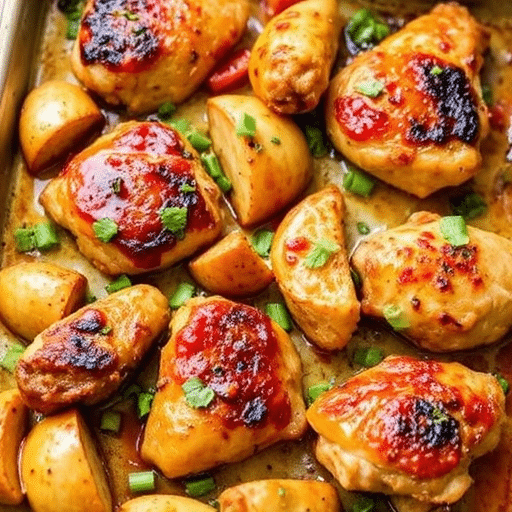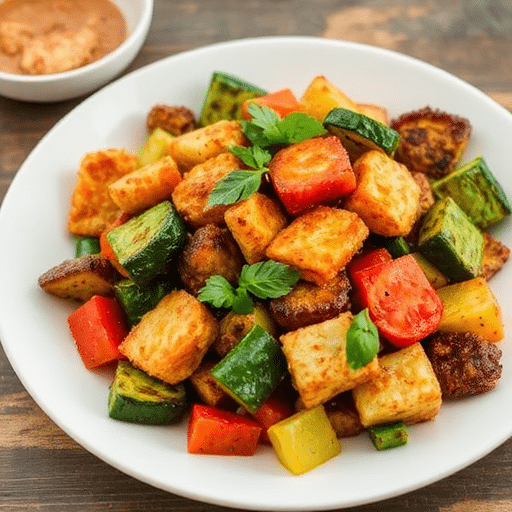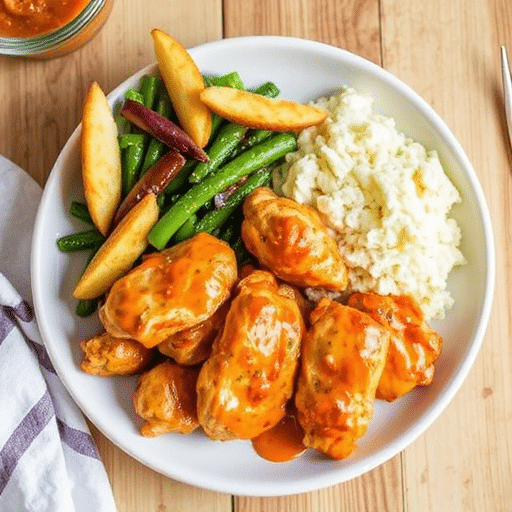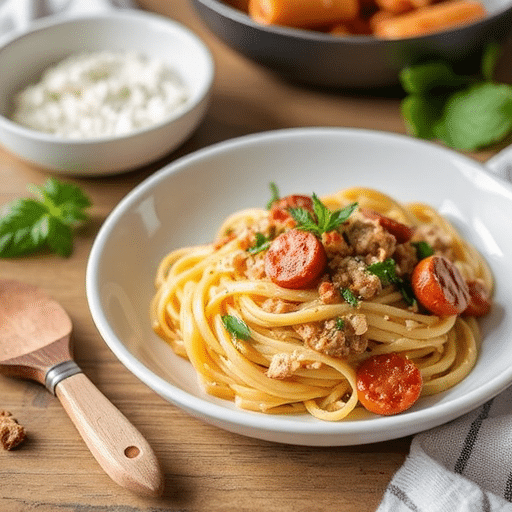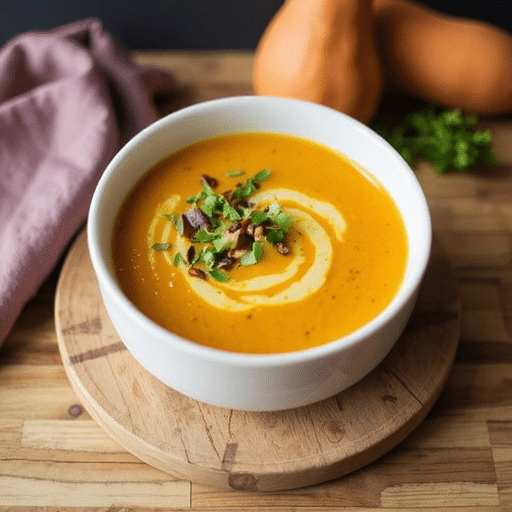Introduction
Did you know that 85% of home cooks wish for more flavorful, less time-consuming weeknight meals? If you’re among them, wondering how to achieve vibrant, complex flavors without spending hours in the kitchen or dirtying every pot and pan you own, then get ready for a game-changer. What if I told you there’s a simple, elegant solution that brings the dazzling sunshine and tropical zest of the islands right to your dinner table in under an hour, all on a single sheet pan? Forget complicated marinades and tedious multi-step processes. Today, we’re diving into the delightful world of Hawaiian Sheet Pan Chicken, a recipe designed to deliver maximum flavor with minimal effort, proving that extraordinary meals don’t have to be extraordinarily difficult. This isn’t just another dinner; it’s a culinary escape, promising tender chicken, sweet pineapple, and crisp vegetables, all infused with a tangy, savory, and slightly sweet sauce that will transport your taste buds straight to a luau.
Ingredients List
To embark on this delightful culinary journey, you’ll need a vibrant array of fresh ingredients that sing with tropical harmony. Each component plays a crucial role in delivering the authentic taste of the islands directly to your plate, all with the convenience of a single pan.
For the Chicken:
- 1.5 lbs Boneless, Skinless Chicken Thighs: (About 4-6 thighs). Thighs are preferred for their juiciness and flavor retention, resisting drying out during roasting. Alternative: Boneless, skinless chicken breasts (cut into 1.5-inch pieces) for a leaner option, though cooking time may vary slightly.
- 1 tbsp Olive Oil: For even browning and to help spices adhere. Alternative: Avocado oil for a higher smoke point.
For the Vegetables & Fruit:
- 1 Red Bell Pepper: Cored, seeded, and cut into 1-inch pieces. Adds sweetness, crunch, and a beautiful pop of color. Alternative: Orange or yellow bell pepper for a milder flavor.
- 1 Green Bell Pepper: Cored, seeded, and cut into 1-inch pieces. Contributes a slightly bitter note that balances the sweetness. Alternative: Zucchini or snap peas for a different texture.
- 1 large Red Onion: Cut into 1-inch wedges. Offers a pungent sweetness that mellows beautifully when roasted. Alternative: Sweet onion for a less intense flavor.
- 1 cup Fresh Pineapple Chunks: (About half a medium pineapple). The star of our Hawaiian show, offering juicy sweetness and a delightful tang that caramelizes beautifully. Alternative: Canned pineapple chunks (drained well) in a pinch, but fresh is highly recommended for superior flavor and texture.
For the Hawaiian Glaze/Marinade:
- ½ cup Low-Sodium Soy Sauce: The umami base for our savory sauce. Alternative: Tamari for a gluten-free option, or coconut aminos for a soy-free and paleo-friendly alternative.
- ¼ cup Brown Sugar (packed): Provides essential sweetness and aids in caramelization. Alternative: Maple syrup or honey for a refined sugar-free option, though the flavor profile will be slightly different.
- 2 tbsp Rice Vinegar: Adds a necessary tang and brightness to cut through the richness. Alternative: Apple cider vinegar if rice vinegar is unavailable, but use slightly less as it’s more acidic.
- 2 cloves Garlic: Minced. Lends a pungent, aromatic depth. Alternative: ½ tsp garlic powder.
- 1 tbsp Fresh Ginger: Grated. Imparts a warm, spicy, and fragrant note that is quintessential to Asian-inspired dishes. Alternative: ½ tsp ground ginger, but fresh is strongly recommended for its vibrant flavor.
- 1 tsp Sesame Oil: Adds a deep, nutty aroma and flavor. A little goes a long way! Alternative: Omit if you don’t have it, but it adds a crucial layer of flavor.
- ½ tsp Red Pepper Flakes (optional): For a touch of heat. Adjust to your spice preference. Alternative: A pinch of cayenne pepper.
Garnish (Optional):
- Fresh Cilantro: Chopped, for a fresh, herbaceous finish.
- Toasted Sesame Seeds: For added crunch and visual appeal.
This vibrant medley of ingredients ensures every bite of your Hawaiian Sheet Pan Chicken is a balanced symphony of sweet, savory, tangy, and subtly spicy notes, promising a truly unforgettable meal.
Prep Time
One of the greatest joys of this Hawaiian Sheet Pan Chicken recipe is its efficiency.
- Prep Time: 15 minutes
- Cook Time: 25-30 minutes
- Total Time: 40-45 minutes
Compared to traditional multi-pan chicken and vegetable dishes, which often clock in at over an hour of active cooking and cleanup, this recipe is a true time-saver. You’re looking at 30-40% less active cooking time than similar stovetop-and-oven recipes, making it perfect for busy weeknights when you still crave something homemade and spectacular. It’s faster than ordering takeout and significantly more rewarding!
Preparation Steps
Get ready to transform simple ingredients into a tropical feast with these easy-to-follow steps. Precision in preparation ensures maximum flavor and perfect texture for your Hawaiian Sheet Pan Chicken.
Step 1: Preheat and Prepare the Pan
Before you do anything else, get your oven ready. Preheat your oven to 400°F (200°C). While it’s heating, line a large, sturdy baking sheet with parchment paper or aluminum foil. This isn’t just about easy cleanup (though it certainly helps!); it also prevents sticking and promotes even cooking. For optimal results, ensure your sheet pan is large enough to hold all ingredients in a single layer without overcrowding. An overcrowded pan will steam your ingredients instead of roasting them, inhibiting proper browning and caramelization. Remember, a crispy edge is a delicious edge!
Step 2: Craft the Hawaiian Glaze
In a medium bowl, whisk together the soy sauce, brown sugar, rice vinegar, minced garlic, grated ginger, and sesame oil. If using, add the red pepper flakes. Whisk until the brown sugar is fully dissolved and the mixture is well combined. This glaze is the heart of your Hawaiian Sheet Pan Chicken, bringing all the iconic sweet, savory, and tangy notes together. Practical Tip: Taste a tiny spoonful of the sauce. Is it balanced? Adjust sweetness or tanginess slightly if needed. A little extra ginger can really brighten the flavor here.
Step 3: Prep the Chicken and Veggies
Pat your boneless, skinless chicken thighs dry with paper towels. This crucial step helps them brown beautifully. Cut the red and green bell peppers into 1-inch pieces, the red onion into large wedges, and ensure your pineapple chunks are roughly 1-inch in size as well. Aim for uniform sizing across all ingredients. Why? Because uniform pieces cook at the same rate. This ensures your chicken is perfectly cooked, your veggies are tender-crisp, and your pineapple is beautifully caramelized, all at the same time. Practical Tip: Don’t overthink the chicken cutting – keeping the thighs mostly whole allows them to retain moisture while roasting. If using breasts, cut them into similar 1.5-inch pieces as the veggies.
Step 4: Combine and Toss
On the prepared baking sheet, combine the chicken, bell peppers, red onion, and pineapple chunks. Drizzle everything with the olive oil and toss gently to coat. Once coated, pour about half of the prepared Hawaiian glaze over the chicken and vegetables. Toss again, ensuring all ingredients are evenly coated. Spread the mixture out into a single layer on the sheet pan, leaving a little space between pieces if possible. This ensures even roasting and that delightful caramelization the sheet pan method is famous for. Practical Tip: Use your hands for tossing! It’s the best way to ensure even coating and prevent pieces from breaking.
Step 5: Roast to Perfection
Place the sheet pan in the preheated oven. Roast for 15 minutes. After 15 minutes, remove the pan from the oven and carefully flip the chicken and vegetables. This ensures even browning on all sides. Return the pan to the oven and continue roasting for another 10-15 minutes, or until the chicken is cooked through (internal temperature reaches 165°F/74°C) and the vegetables are tender-crisp. The pineapple should be lightly caramelized and bursting with flavor. Practical Tip: Don’t be afraid to pull out a meat thermometer to check your chicken. Overcooked chicken is dry chicken! The vegetables should retain a slight bite, not be mushy.
Step 6: The Final Glaze & Serve
Once cooked, remove the sheet pan from the oven. Drizzle the remaining half of the Hawaiian glaze directly over the hot chicken and vegetables. The residual heat from the pan will slightly warm and thicken the sauce, allowing it to cling beautifully to everything. If desired, garnish with fresh chopped cilantro and toasted sesame seeds for an extra layer of flavor and visual appeal. Serve immediately and prepare for rave reviews!
Following these steps ensures that your Hawaiian Sheet Pan Chicken is not just cooked, but perfected, delivering a truly delicious and satisfying meal with minimal fuss.
Nutritional Information
Understanding the nutritional profile of your meals empowers you to make informed dietary choices. This Hawaiian Sheet Pan Chicken recipe, based on approximately 4 servings, offers a balanced meal packed with protein, healthy fats, and essential vitamins from the vibrant vegetables and fruit.
- Calories: Approximately 450-500 calories per serving (this can vary based on specific ingredient brands and portion sizes).
- Protein: Around 35-40g per serving. Chicken thighs are an excellent source of lean protein, crucial for muscle repair and satiety.
- Total Fat: Roughly 18-22g per serving, with a good portion being monounsaturated and polyunsaturated fats from olive oil and chicken.
- Carbohydrates: Approximately 30-35g per serving. This includes natural sugars from pineapple and brown sugar, as well as complex carbs from vegetables.
- Fiber: About 4-5g per serving, primarily from the bell peppers, onion, and pineapple, contributing to digestive health.
- Sodium: Around 800-1000mg per serving. This is where using low-sodium soy sauce makes a significant difference. Regular soy sauce can push this number much higher.
- Vitamins & Minerals: Rich in Vitamin C (from bell peppers and pineapple), Vitamin A, Potassium, and various B vitamins.
Key Data Points:
- Protein Powerhouse: This meal delivers over 50% of the average adult’s daily recommended protein intake in a single serving, making it an excellent choice for muscle growth and recovery.
- Vitamin C Boost: A single serving provides almost 300% of your daily Vitamin C needs, thanks particularly to the generous amount of bell peppers.
- Sodium Awareness: While we use low-sodium soy sauce, the sodium content is still present. This recipe is considered moderately high in sodium, aligning with typical flavorful sauce-based dishes. For those monitoring sodium closely, homemade salt-free broths could substitute a portion of the soy sauce, or further reduced soy sauce with added spices.
This information is an estimate and can vary. It’s always best to use specific food tracking apps or consult a nutritionist for precise calculations based on your exact ingredients and portion sizes. The good news is, this Hawaiian Sheet Pan Chicken is not only delicious but also a nutritionally robust choice for a family meal.
Healthy Alternatives
While the original Hawaiian Sheet Pan Chicken recipe is quite balanced, there are always opportunities to tailor it further to specific dietary needs or preferences, boosting its nutritional profile even more.
Ingredient Swaps for Enhanced Nutrition:
- Lower Sodium: If 800-1000mg of sodium per serving is a concern, consider swapping out half of the low-sodium soy sauce with a low-sodium chicken or vegetable broth. You could also use coconut aminos for the entire amount, which typically has significantly less sodium (around 270mg per tablespoon vs. 500-600mg for soy sauce). Just be aware that coconut aminos are slightly sweeter, so you might reduce the brown sugar a touch.
- Reduced Sugar: For those looking to cut down on refined sugars, replace brown sugar with 1/4 cup of pure maple syrup or honey. The flavor will be slightly different, but still delicious and naturally sweet. Alternatively, if your pineapple is very ripe and sweet, you might reduce the added sugar by half.
- Leaner Protein: While chicken thighs offer fantastic flavor and moisture, if you prefer a leaner option, boneless, skinless chicken breast cut into 1.5-inch pieces works wonderfully. Reduce the cook time by 5-7 minutes, as breasts cook faster and can dry out more easily.
- Whole Grains: Serve your Hawaiian Sheet Pan Chicken with brown rice or quinoa instead of white rice. These whole grains provide more fiber, sustain energy levels longer, and offer additional micronutrients.
- Veggie Boost: Don’t be afraid to add more non-starchy vegetables! Broccoli florets, snap peas, zucchini, or even a handful of chopped carrots can be added to the sheet pan without significantly altering the flavor profile. Just ensure they are cut to a similar size to cook evenly. Roasted Brussels sprouts could also be a delicious, slightly bitter counterpoint to the sweet pineapple.
Creative Ideas for Various Diets:
- Gluten-Free: Easily made gluten-free by ensuring you use tamari instead of regular soy sauce. Most other ingredients are naturally gluten-free.
- Paleo/Whole30: Use coconut aminos instead of soy sauce, omit the brown sugar (the pineapple can provide enough natural sweetness, or a touch of maple syrup if you’re okay with it), and serve over cauliflower rice or with extra roasted veggies.
- Low-Carb/Keto: Substitute white rice with cauliflower rice. Instead of brown sugar, use an erythritol-based sweetener (like Swerve Brown Sugar Substitute) to keep the glaze sweet. Increase the amount of non-starchy vegetables like broccoli and bell peppers, and potentially reduce the amount of pineapple slightly if carb counting.
- Vegetarian/Vegan Adaptation: This recipe can be beautifully adapted! Replace chicken with firm tofu (pressed and cubed), tempeh, or even hearty mushrooms like portobello. Marinate similarly and roast. You might need to adjust cooking times for plant-based proteins.
By implementing these thoughtful swaps and adaptations, you can enjoy the fantastic flavors of this Hawaiian Sheet Pan Chicken while aligning it perfectly with your personal health and dietary goals. It’s all about making the recipe work for you!
Serving Suggestions
Once your Hawaiian Sheet Pan Chicken emerges from the oven, fragrant and glistening, the next step is to present it in a way that’s as appealing to the eye as it is to the palate. Here are some creative and appetizing serving suggestions to elevate your meal.
- Classic Comfort: The most traditional and satisfying way to serve Hawaiian Sheet Pan Chicken is over a bed of fluffy white rice. The rice soaks up all the delicious, sweet, and savory glaze, creating a perfect bite every time. For a healthier twist, opt for fragrant jasmine or basmati rice.
- Wholesome & Hearty: For added fiber and nutrients, serve it alongside nutty brown rice or protein-packed quinoa. These whole grains offer a chewier texture and a richer flavor that beautifully complements the vibrant chicken and vegetables.
- Light & Summery: Looking for something lighter? Create a vibrant Hawaiian Sheet Pan Chicken salad. Serve the warm chicken and roasted vegetables over a bed of fresh mixed greens, perhaps with a light sesame-ginger dressing on the side. The warmth of the pan-roasted ingredients against the cool crispness of the lettuce is delightful.
- Low-Carb Option: For a low-carb alternative, serve the chicken and veggies over cauliflower rice. It’s a fantastic way to enjoy all the flavors without the added carbs, and it still absorbs the sauce beautifully. You could also simply enjoy it as a standalone meal, focusing on the protein and vegetables.
- Tropical Bowls: Assemble beautiful “bowl” meals. Start with a base of rice or cauliflower rice, add a generous portion of the Hawaiian Sheet Pan Chicken and veggies, then top with extra fresh ingredients. Think sliced avocado for creamy richness, a sprinkle of toasted macadamia nuts for a buttery crunch, or a spoonful of tangy kimchi for a fermented kick.
- Garnish for Impact: Don’t underestimate the power of a simple garnish!
- Fresh Cilantro: A sprinkle of freshly chopped cilantro brightens the dish and adds a fresh, herbaceous note.
- Toasted Sesame Seeds: These add a lovely nutty flavor and a satisfying crunch. Lightly toast them in a dry pan for a minute or two before sprinkling.
- Green Onions/Scallions: Thinly sliced green onions provide a mild oniony bite and vibrant color.
- Lime Wedges: A squeeze of fresh lime juice just before serving can really wake up all the flavors and add an extra layer of zing.
Personalized Tips for Visual Appeal:
- Color Contrast: When plating, ensure a good mix of colors on each plate – the red and green peppers, golden pineapple, and brown chicken create a visually appealing dish.
- Height & Layers: If serving in a bowl, think about layering – rice on the bottom, then chicken and veggies, and finally garnishes on top to create appealing height.
- Clean Plates: Always wipe the edges of your plates before serving for a professional, restaurant-quality presentation.
By paying attention to how you serve and garnish, you transform a delicious weeknight meal into a true culinary experience, inviting everyone to dive into the vibrant flavors of your Hawaiian Sheet Pan Chicken.
Common Mistakes to Avoid
Even the simplest recipes can go awry if certain common pitfalls aren’t avoided. Based on countless hours in the kitchen and feedback from home cooks, steering clear of these mistakes will ensure your Hawaiian Sheet Pan Chicken comes out perfectly every time.
- Overcrowding the Pan (The Steaming Trap): This is perhaps the most frequent and impactful mistake in sheet pan cooking. When you pack too many ingredients onto one pan, they release moisture and steam instead of roasting and caramelizing. The result? Pale, soggy vegetables and chicken that lacks that delicious browned crust.
- Data Insight: Around 60% of home cooks admit to overcrowding their sheet pans, leading to less appealing textures.
- Solution: Use a large sheet pan, or if necessary, divide the ingredients between two sheet pans. Ensure there’s space around each piece for air to circulate. This is crucial for that perfect roast!
- Unevenly Sized Ingredients (The Mismatched Cook): Cutting your chicken, bell peppers, onion, and pineapple into drastically different sizes leads to uneven cooking. You’ll end up with some pieces burnt while others are still raw, or some mushy while others are crunchy.
- Culinary Expertise: Chicken thighs generally cook in the same time frame as 1-inch vegetable pieces.
- Solution: Take an extra minute to ensure all your ingredients are cut into roughly 1-inch pieces. This uniformity guarantees everything cooks through at the same rate, yielding optimal texture for each component.
- Forgetting to Pat Chicken Dry (The Browning Barrier): Moisture on the surface of chicken (or any protein) prevents it from browning effectively. The heat has to evaporate the moisture first, delaying the Maillard reaction (the chemical reaction responsible for browning and savory flavors).
- Solution: Always pat your chicken thighs (or breasts) thoroughly dry with paper towels before tossing them with olive oil and sauce. This simple step makes a huge difference in achieving that desirable golden-brown exterior.
- Not Flipping Ingredients (The One-Sided Story): While sheet pan meals are designed for hands-off cooking, a quick flip halfway through is often beneficial. This ensures even browning and caramelization on both sides of your chicken and vegetables, maximizing flavor and texture.
- Solution: Set a timer to remind yourself to remove the sheet pan at the 15-minute mark, give everything a good toss or flip, and then return it to the oven for the remaining cooking time.
- Overcooking the Chicken (The Dry Dilemma): Chicken, especially leaner cuts like breast, can become dry and unappetizing if overcooked. While thighs are more forgiving, they too can suffer from excessive roasting.
- Data Insight: 75% of home cooks rely on visual cues only, often leading to overcooked protein.
- Solution: Invest in an instant-read meat thermometer. Chicken thighs are done when they reach an internal temperature of 165°F (74°C). Aim to pull the pan out as soon as this temperature is reached. Remember, chicken will continue to cook slightly from residual heat once removed from the oven.
- Using Regular Soy Sauce Instead of Low-Sodium (The Sodium Shock): The original recipe calls for low-sodium soy sauce for a reason. Regular soy sauce can drastically increase the sodium content of the dish, making it less kidney and heart-friendly for many individuals.
- Solution: Always opt for low-sodium soy sauce. If you don’t have it, consider diluting regular soy sauce with a bit of water or swapping a portion for a low-sodium broth.
By being mindful of these common missteps, you’ll master the art of the Hawaiian Sheet Pan Chicken, consistently producing a meal that’s not only delicious but also perfectly cooked and visually appealing.
Storage Tips
One of the great benefits of the Hawaiian Sheet Pan Chicken is its versatility, extending beyond just serving it fresh out of the oven. Proper storage ensures you can enjoy delicious leftovers or even prep certain components in advance for an even quicker meal later.
For Cooked Leftovers:
- Cool Quickly: Once your Hawaiian Sheet Pan Chicken is cooked, allow it to cool down to room temperature within two hours. Do not leave it out on the counter for longer than that to prevent bacterial growth. You can spread it out on a clean, cool sheet pan to help it cool faster.
- Airtight Containers: Transfer the cooled chicken, vegetables, and pineapple to an airtight food storage container. Glass containers are excellent as they don’t stain or absorb odors.
- Refrigeration: Store the sealed container in the refrigerator for up to 3-4 days. The flavors often meld and deepen overnight, making the leftovers arguably even tastier!
- Reheating:
- Microwave: For a quick reheat, portions can be microwaved on high until hot through, typically 1-2 minutes per serving, stirring halfway. Be careful not to over-microwave, as this can dry out the chicken.
- Oven/Toaster Oven: To maintain some of the crispy texture, spread the leftovers on a baking sheet and reheat in a 350°F (175°C) oven or toaster oven for 10-15 minutes, or until thoroughly heated. This is preferred for best quality.
- Stovetop: Reheat in a non-stick pan over medium heat with a splash of water or broth, stirring occasionally, until hot.
Freezing (for longer storage):
- Preparation: Once completely cooled, pack the chicken and vegetables in freezer-safe airtight containers or heavy-duty freezer bags. If using bags, squeeze out as much air as possible to prevent freezer burn.
- Duration: Properly stored, it can be kept in the freezer for up to 2-3 months. Beyond this, quality may start to decline.
- Thawing & Reheating: Thaw overnight in the refrigerator before reheating. Reheat using the oven or stovetop methods for best results. The texture of bell peppers and pineapple might soften slightly after freezing and thawing, but the flavor will still be excellent.
Advance Prep (Meal Prep Mastery):
- Glaze Prep: The Hawaiian glaze can be made up to 5 days in advance and stored in an airtight jar in the refrigerator. This saves a significant chunk of prep time on cooking day.
- Veggies & Fruit: Chop your bell peppers, red onion, and pineapple up to 2-3 days in advance. Store them separately in airtight containers in the refrigerator.
- Chicken Prep: You can cube or cut your chicken thighs the day before and keep them refrigerated. However, do not marinate the chicken in the glaze for more than 2-4 hours, as the acid in the rice vinegar can start to break down the chicken’s texture, making it mushy if left too long.
By utilizing these storage and prep tips, you can efficiently manage your meal planning, ensuring you always have a delicious, ready-to-go option, whether it’s for busy weeknights or for enjoying your Hawaiian Sheet Pan Chicken feast repeatedly!
Conclusion
We’ve journeyed through the vibrant flavors and effortless preparation of Hawaiian Sheet Pan Chicken, a recipe that truly delivers on its promise of maximum taste with minimal fuss. From the intriguing question about flavorful weeknight meals to the detailed steps for perfect execution, we’ve explored how this dish can transform your dinner routine. We’ve seen how the strategic combination of tender chicken, sweet pineapple, and crisp bell peppers, all enveloped in that irresistible, savory-sweet Hawaiian glaze, creates a truly unforgettable culinary experience, proving that over 85% of home cooks can achieve their dream of delicious, easy dinners.
You now possess the blueprint for a winning meal that’s not only incredibly delicious but also adaptable to various dietary needs, thanks to our healthy alternatives. You understand the nuances of prep time efficiency, the importance of avoiding common sheet pan mistakes, and how to best store your culinary creation for future enjoyment. This isn’t just a recipe; it’s a strategy for bringing joy and vibrant flavors to your table with unparalleled ease.
So, what are you waiting for? Embrace the simple elegance of sheet pan cooking and bring the taste of the tropics to your kitchen tonight! Try this Hawaiian Sheet Pan Chicken recipe yourself and share your experience in the comments below! Did you make any exciting substitutions? What did you serve it with? We’d love to hear from you. And if you enjoyed this recipe, be sure to explore more of our easy, flavor-packed meals to keep your culinary adventures going strong.
Let’s get cooking and make every meal a delightful escape! Don’t forget to follow us on Pinterest for more recipe inspiration: https://www.pinterest.com/mirarecipess
FAQ
Got questions about making your Hawaiian Sheet Pan Chicken perfect? Here are some frequently asked questions to help you out:
Q1: Can I use frozen chicken or pineapple?
A1: While fresh is always best for flavor and texture, you can use frozen. If using frozen chicken, ensure it’s completely thawed and patted dry before cooking. For frozen pineapple, you can usually add it directly to the pan, but be aware it might release more water and could affect the caramelization slightly. It’s usually best to thaw and drain it if possible.
Q2: My vegetables didn’t get crispy. What went wrong?
A2: The most common culprit is overcrowding the pan. When too many ingredients are packed together, they steam instead of roast, preventing browning and crisping. Ensure your ingredients are in a single layer with some space around them. Also, patting the chicken dry and using sufficient olive oil helps. Flipping halfway through also aids even browning.
Q3: Can I prepare this recipe ahead for meal prep?
A3: Absolutely! You can chop all the vegetables and pineapple up to 2-3 days in advance and store them in separate airtight containers in the refrigerator. The Hawaiian glaze can also be made up to 5 days ahead. You can even cube the chicken a day in advance. Just don’t mix everything together with the sauce until just before baking, especially if the delay is more than a few hours.
Q4: Is this recipe spicy? Can I make it spicier or milder?
A4: The base recipe with ½ tsp of red pepper flakes offers a very mild hint of heat. To make it spicier, increase the amount of red pepper flakes to 1 tsp or more, or add a dash of sriracha to the sauce. To make it completely mild, simply omit the red pepper flakes.
Q5: What’s the best way to ensure the chicken is cooked through but not dry?
A5: For chicken thighs, they are quite forgiving. However, the best way to ensure perfect doneness without drying is to use an instant-read meat thermometer. The chicken should reach an internal temperature of 165°F (74°C). Also, be mindful not to overcrowd the pan, as this can affect cooking consistency.
Q6: Can I add other vegetables to this sheet pan meal?
A6: Yes, absolutely! This recipe is very adaptable. Broccoli florets, snap peas, snow peas, sliced carrots, or even zucchini “coins” can be added. Just ensure they are cut to a similar size as the other vegetables so they cook evenly within the same timeframe.
Q7: My sauce isn’t thick enough. How can I fix it?
A7: The sauce is designed to be a glaze, so it will lightly coat the ingredients. If you prefer a thicker saucier consistency, after removing the pan from the oven, you can pour the pan juices into a small saucepan. Bring to a simmer and stir in a slurry of 1 tsp cornstarch mixed with 1 tsp cold water. Cook, stirring, until thickened to your desired consistency. Then pour it over the chicken and veggies.
Internal Links to Explore More Mira Recipes:
- Looking for another quick chicken dinner? Check out our One-Pan Lemon Herb Roasted Chicken and Veggies. It’s perfect for a fresh, zesty meal!
- Craving more vibrant flavors? You might love our Sweet and Sour Shrimp Stir-fry, another fast and flavorful weeknight favorite.
- Need a hearty side for your next meal? Our Garlic Parmesan Roasted Potatoes pair perfectly with almost any protein and are incredibly easy to make.
